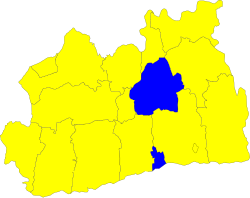Copthorne Hundred: Difference between revisions
Created page with "right|thumb|250px|The Hundred of Copthorne in Surrey '''Copthorne''' is a hundred of Surrey. The Diomesday Book lists in the Copth..." |
No edit summary |
||
| Line 1: | Line 1: | ||
[[File:Copthorne Hundred - Surrey.svg|right|thumb|250px|The Hundred of Copthorne in Surrey]] | [[File:Copthorne Hundred - Surrey.svg|right|thumb|250px|The Hundred of Copthorne in Surrey]] | ||
'''Copthorne''' is a hundred of [[Surrey]]. | '''Copthorne''' is a hundred of [[Surrey]]. The [[Domesday Book]] lists in the Copthorne Hundred the manors of [[Ashtead]], Burgh, Cuddington, [[Epsom]], [[Ewell]], [[Fetcham]], [[Headley, Surrey|Headley]], [[Leatherhead]], [[Mickleham, Surrey|Mickleham]], Pachevesham (within Leatherhead parish), [[Tadworth]], Thorncroft and [[Walton-on-the-Hill]].<ref>[http://www.epsomandewellhistoryexplorer.org.uk/DomesdayBook.html Domesday book]</ref> | ||
The | The hundred has two exclaves, areas of other parishes dominated by manors and sometimes churches within it: in [[Weybridge]] and [[Newdigate]]. | ||
In the Domesday Book, the settlements of [[Ashtead]], [[Fetcham]] and [[Mickleham, Surrey|Mickleham]] were included in the [[Wallington Hundred]], which the line of county historians cited by the [[Victoria County History]] of 1911 who have examined the Patent Rolls and similar state collections of deeds, royal letters and documents, such as Owen Manning and John Aubrey agree was by mistake.<ref>{{brithist|43046|The hundred of Wallington: Introduction and map}} – {{VCH|vol=4}}</ref> | |||
In the | |||
The [[Victoria County History]], based on ecclesiastical records, has determined that the following ancient parishes constitute the hundred: | The [[Victoria County History]], based on ecclesiastical records, has determined that the following ancient parishes constitute the hundred: | ||
Revision as of 21:08, 20 July 2015

Copthorne is a hundred of Surrey. The Domesday Book lists in the Copthorne Hundred the manors of Ashtead, Burgh, Cuddington, Epsom, Ewell, Fetcham, Headley, Leatherhead, Mickleham, Pachevesham (within Leatherhead parish), Tadworth, Thorncroft and Walton-on-the-Hill.[1]
The hundred has two exclaves, areas of other parishes dominated by manors and sometimes churches within it: in Weybridge and Newdigate.
In the Domesday Book, the settlements of Ashtead, Fetcham and Mickleham were included in the Wallington Hundred, which the line of county historians cited by the Victoria County History of 1911 who have examined the Patent Rolls and similar state collections of deeds, royal letters and documents, such as Owen Manning and John Aubrey agree was by mistake.[2]
The Victoria County History, based on ecclesiastical records, has determined that the following ancient parishes constitute the hundred:
- Ashtead
- Epsom
- Leatherhead
- Banstead
- Ewell
- Mickleham
- Chessington
- Fetcham
- Cuddington
- Headley
- Walton on the Hill
- Newdigate (part of)
Ownership and late transactions
Copthorne was a royal hundred (to the extent its overarching overlordship affected the manors and common land), and remained in the hands of the Crown, though James I of England leased it for 21 years to Thomas Jenkins in 1617. In a subsidy roll of the 14th century it was said to be worth £47 15s. 6¼d. and with Effingham Half-Hundred the various land units within it were assessed in total for ship money at £136 16s. 4d. at the third such levy in 1636.
Domesday survey
Copthorne appears in the Book as Copededorne.
Outside links
- Vision of Britain map of the boundaries
References
- ↑ Domesday book
- ↑ The hundred of Wallington: Introduction and map – A History of the County of - Volume : {{{2}}} (Victoria County History)